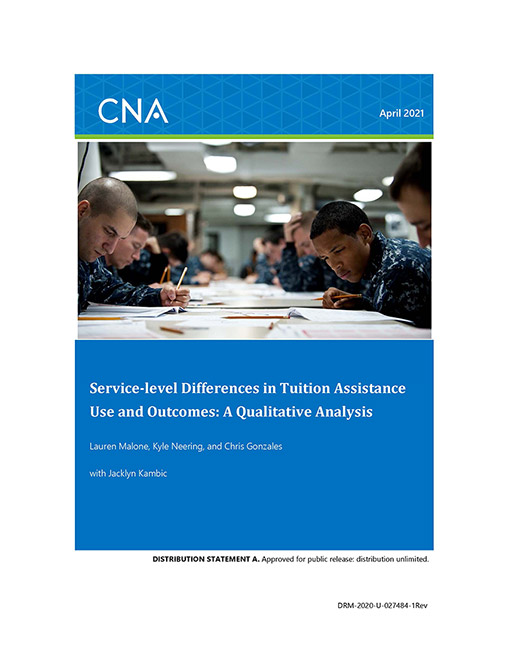Background
Tuition Assistance (TA) is the primary education benefit that the Department of Defense (DOD) provides to Service members to ease the financial burdens of continuing education while serving in the military. It also aims to make them more academically ready—i.e., set them up for academic success (via degree attainment and course completion)—both in service and after they transition to civilian life. A 2017 CNA study revealed several Service-level differences in TA use, which ultimately were related to such outcomes as course completion and degree attainment. That analysis revealed, for example, that enlisted Airmen and Sailors are more likely than Soldiers or Marines to use TA and successfully complete their courses. It was unclear, however, what led to such differences. Possible reasons include differences in TA use policy, Service members’ abilities to use TA, Service members’ educational goals, and Service- level incentives for TA use.
To better understand the driving factors behind Service-level differences in TA use and outcomes, the DOD Voluntary Education Office asked CNA to evaluate Service-level differences in continuing education incentives and motivations, TA access, and TA awareness. The ultimate objective of this effort is to equalize access and awareness across the Services while minimizing the risks of course and degree noncompletion.
Approach
In this study, we took a qualitative approach to answering these questions and focused primarily on enlisted Service members because they make up the majority of the TA-using population. Our approach included a comprehensive policy review, conversations with on- installation education counselors and other relevant subject matter experts (SMEs), and focus groups (FGs) with both officers and enlisted Service members (junior enlisted, TA-using mid- grade enlisted, non-TA-using mid-grade enlisted, and senior enlisted). Synthesizing these inputs allowed us to hypothesize why we observe Service-level differences in both TA use and outcomes (such as course completion and degree attainment) and ultimately to recommend ways to maximize TA use and equalize overall TA success across the Services. This study was originally published in June 2020, and our focus groups and SME discussions were conducted in the summer/fall of 2019. Some of the findings and recommendations discussed in this report will have been resolved or acted on prior to the publication of this final version, approved for public release. This study and its resulting recommendations should be viewed as representative of the state of Service-level TA differences at the time of the original study’s execution.
We caution readers that the generalizability of our findings is questionable. This is not only because we visited only one installation per service, but also because our focus groups were based on a convenience sample, with some demographic groups being over- or under- represented. Without further study, we cannot be certain that our findings regarding any one Service would apply to Service members throughout the Service, as opposed to only reflecting experiences of those in our FGs (and on that specific installation). More generalizable findings would require a representative survey. That said, our findings do represent inputs from a diverse group of people, and we are confident in those findings that emerge consistently across the FGs and find them informative as to how TA policies, TA practices, and Service member perceptions about TA differ across Services. Our findings will assist the Department of Defense in identifying particular areas in need of greater focus, thereby informing how to shape future policy with the end-goal of further standardizing the TA learner experience across the Services.
Findings
Our findings reveal that the variation across the Services in TA policy, TA understanding, and occupational responsibilities and operational tempo (OPTEMPO), as well as in support from senior leaders and immediate supervisors, likely is the primary driver of these differences. The most important policy differences are those that limit Service members’ TA use, including when they are first able to use TA. Prominent among these are time-in-service restrictions: from September 2013 through April 2019, the Marine Corps required Marines to have served two years before using TA, and the Navy implemented the same restriction in October 2019.
Download reportDISTRIBUTION STATEMENT A. Approved for public release: distribution unlimited.
Details
- Pages: 80
- Document Number: DRM-2020-U-027484-1Rev
- Publication Date: 4/30/2021
